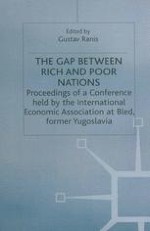1972 | OriginalPaper | Chapter
The Grants Economy and the Development Gap
Authors : Kenneth E. Boulding, Martin Pfaff
Published in: The Gap Between Rich and Poor Nations
Publisher: Palgrave Macmillan UK
Included in: Professional Book Archive
Activate our intelligent search to find suitable subject content or patents.
Select sections of text to find matching patents with Artificial Intelligence. powered by
Select sections of text to find additional relevant content using AI-assisted search. powered by
The problem of the gap between rich and poor countries is a familiar one, and we need not spend much time in repeating what everybody knows about it. Nevertheless Figure 6.1 may throw some additional light on the nature of the problem. Here we plot, for as many countries as data could be obtained, the rate of growth of per capita G.N.P. against the per capita G.N.P. itself on a logarithmic scale.1 It is clear that the nations of the world divide out into two fairly distinct groups, which we may call the ‘A’ nations and the ‘B’ nations. The A nations are clearly participating in a long-term growth process of some kind. They lie approximately on a straight line, suggesting that the growth process itself is logistic, with the rate of growth diminishing as growth proceeds. For the A nations it is clear that ‘the poorer the faster, the richer the slower’. The implication of this is that for these nations growth will proceed until all are about equally rich and are proeeeding towards an asymptotic rate of growth which is zero, which seems to be somewhere between $5,000 and $10,000 of the per capita G.N.P. Two interesting facts emerge about the A nations — they are nearly all within the Temperate Zone, or just outside it, and it does not seem to make any difference, at least from this point of view, whether they are socialist or capitalist.
